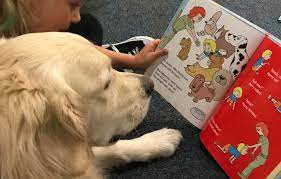In a world where screens often compete for children's attention, a heartwarming trend is gaining momentum, one that pairs the companionship of rescue dogs with the magic of reading. "Paws for Progress" programs are on the rise, where therapy dogs are lending their furry ears and unconditional support to young readers. These programs are transforming the way kids learn and love to read, boosting their confidence and literacy skills. Let's dive into the heartwarming story of how rescue dogs are making a positive impact on children's education.
The Power of Paws for Progress
Paws for Progress programs are simple yet brilliant. Children, often struggling with reading or lacking confidence in their abilities, are paired with therapy dogs in a quiet and supportive environment. As the children read aloud to their canine companions, the magic happens. The dogs don't judge, correct, or interrupt, but they listen with unwavering attention. This non-judgmental audience creates a safe space for children to practice their reading skills without fear of embarrassment, criticism, or performance anxiety.
The Trend's Rapid Growth
The trend of using rescue dogs in reading programs has been on the rise in recent years. What started as a local experiment has now become a global phenomenon. Several factors contribute to this rapid growth:
-
Proven Success: Multiple studies have shown that reading to dogs can lead to significant improvements in reading skills. As a result, educational institutions are embracing these programs to enhance their reading curricula.
-
Boosting Confidence: Kids who read to dogs often become more confident readers. They are more willing to take risks, try more challenging books, and ultimately develop a love for reading.
-
Social and Emotional Benefits: Reading to dogs not only helps with literacy but also promotes social and emotional development. Children often bond with their canine reading companions and feel a sense of accomplishment.
-
Positive Media Coverage: Heartwarming stories of children and therapy dogs have received extensive media coverage, which has encouraged the expansion of these programs.
Where Paws for Progress is Thriving
Paws for Progress programs are thriving in a variety of settings:
-
Schools: Many schools have adopted reading programs that involve therapy dogs. Students benefit from reading to dogs during library periods or as part of reading intervention programs.
-
Libraries: Public libraries host regular reading events where therapy dogs are available to listen to young readers. This has created a welcoming space for children to engage with books.
-
Hospitals: Paws for Progress programs have extended to hospitals where children receiving medical treatment can enjoy the comfort and support of therapy dogs while reading.
-
Special Needs Schools: These programs have made a significant impact on children with special needs or learning disabilities, helping them improve their communication and literacy skills.
-
Community Centers: Reading and literacy programs in community centers have incorporated therapy dogs as part of their outreach efforts.
The Bond Between Kids and Canines
The connection between children and therapy dogs is truly remarkable. These animals offer more than a listening ear; they provide a comforting presence that reduces anxiety and stress. Many kids look forward to their reading sessions with their four-legged friends, and these bonds often extend beyond the reading program.
Measuring Success
The success of Paws for Progress programs isn't just anecdotal; it's supported by research and observable results. Children who participate in these programs not only show improved reading skills but also demonstrate enhanced:
-
Fluency: Reading to dogs regularly helps children become more fluent readers.
-
Confidence: With each successful reading session, kids' confidence soars.
-
Love for Reading: Many children who were once reluctant readers now embrace books and reading as a joyous pastime.
-
Communication Skills: The positive interactions with therapy dogs can also enhance a child's overall communication skills.
The Role of Therapy Dogs
Therapy dogs are specially trained to be calm, gentle, and patient. They provide a soothing presence that can help children feel more at ease while reading. Their non-judgmental attitude allows children to read without fear of making mistakes or being judged, creating a judgment-free zone where reading becomes an enjoyable experience.
The Human-Dog Connection
The connection between humans and dogs is deep-rooted in history. Dogs have always been our loyal companions, and this bond is no less evident in Paws for Progress programs. As children and dogs interact, a strong and positive bond forms, creating a safe and supportive environment for children to improve their reading skills.
The Future of Reading Education
As Paws for Progress programs continue to gain momentum, it's clear that this trend is here to stay. These programs not only enhance children's reading abilities but also instill a love for books and storytelling. By embracing the power of therapy dogs, educators and parents are creating a brighter future for young readers, one where reading is a joyful journey of discovery and connection.
In a world that sometimes feels dominated by screens and technology, the heartwarming success of Paws for Progress programs reminds us of the enduring and transformative power of the human-animal connection. With the support of their furry friends, children are not only learning to read but also learning to love reading, and that's a trend worth celebrating.
